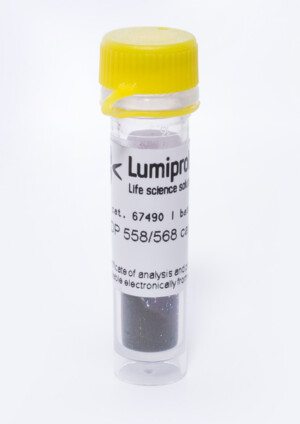BDP® 558/568 carboxylic acid
| Cat. # | Quantity | Price | Lead time | Buy this product |
|---|---|---|---|---|
| 17490 | 1 mg |
$125
|
in stock | |
| 27490 | 5 mg |
$260
|
in stock | |
| 47490 | 25 mg |
$510
|
in stock | |
| 57490 | 50 mg |
$895
|
in stock | |
| 67490 | 100 mg |
$1490
|
in stock |

BDP 558/568 is a universal borondipyrromethene dye with emission in the yellow region of the spectrum. This derivative is a free carboxylic acid.
Absorption and emission spectra of BDP 558/568

Customers also purchased with this product
General properties
| Appearance: | dark colored solid |
| Molecular weight: | 346.16 |
| CAS number: | 150173-72-1 |
| Molecular formula: | C16H13N2BF2O2S |
| Solubility: | good in DCM, DMF, DMSO |
| Quality control: | NMR 1H, HPLC-MS (95%) |
| Storage conditions: | Storage: 24 months after receival at -20°C in the dark. Transportation: at room temperature for up to 3 weeks. Avoid prolonged exposure to light. Desiccate. |
| MSDS: | Download |
| Product specifications |
Spectral properties
| Excitation/absorption maximum, nm: | 561 |
| ε, L⋅mol−1⋅cm−1: | 84400 |
| Emission maximum, nm: | 569 |
| Fluorescence quantum yield: | 0.68 |
| CF260: | 0.00 |
| CF280: | 0.07 |
Product citations
- Kochappan, R.; Cao, E.; Han, S.; Hu, L.; Quach, T.; Senyschyn, D.; Ferreira, V.I.; Lee, G.; Leong, N.; Sharma, G.; Lim, S.F.; Nowell, C.J.; Chen, Z.; von Andrian, U.H.; Bonner, D.; Mintern, J.D.; Simpson, J.S.; Trevaskis, N.L.; Porter, C.J.H. Targeted delivery of mycophenolic acid to the mesenteric lymph node using a triglyceride mimetic prodrug approach enhances gut-specific immunomodulation in mice. Journal of Controlled Release, 2021, 332, 636–651. doi: 10.1016/j.jconrel.2021.02.008
BDP® is a trademark of Lumiprobe
This Product is offered and sold for research purposes only. It has not been tested for safety and efficacy in food, drug, medical device, cosmetic, commercial or any other use. Supply does not express or imply authorization to use for any other purpose, including, without limitation, in vitro diagnostic purposes, in the manufacture of food or pharmaceutical products, in medical devices or in cosmetic products.
Short link - lumiprobe.com/sh/p/3P
The count of items is incorrect.


























 $
$ 
